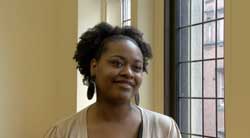Filed Under > Convocation
Studying the Spaces Where Young People Can Just Be
Community-based youth organizations can be safe spaces for emotional and social development. Bianca Baldridge believes they should be taken seriously as a focus of academic discourse
Bianca Baldridge grew up in a working class neighborhood in south Los Angeles, but she attended a magnet high school 45 minutes away at Venice Beach. The school was unusual in several respects: for one thing, Baldridge’s graduating class consisted of just 11 students. For another, Baldridge was able to participate in an after-school leadership development curriculum in which she not only learned but also taught other students and even teachers about leadership development, conflict resolution and strategic planning. The program had a profound impact on Baldridge, who up to that point had been so shy she rarely spoke in class.
“The program was a safe space for me, and doing the community-based leadership gave me confidence,” recalls Baldridge, who will receive her Ph.D. in Sociology and Education this spring. She also formed a lasting appreciation for education conducted outside of traditional classroom settings, and more particularly, for community-based youth organizations.
“Traditional academics are important, but through tutoring and community organizing throughout high school and college, I came to feel that social development and other forms of education matter just as much,” she says. Community-based youth organizations can be ideal educational venues because often “they are places where young people can just be.
“There’s a youth development sensibility that is about relating to young people very differently than traditional classroom teachers do, while still being able to command authority.” Baldridge says. “Classes and meetings in a community-based youth organization often begin simply with the counselor or leader asking everyone, ‘How are you? What’s going on in your life?’ That’s so different from what kids experience in school.”
For her doctoral dissertation at TC, where she has worked closely with faculty members Amy Stuart Wells and Marc Lamont Hill, Baldridge has conducted an ethnographic study of a community-based organization in Harlem, focusing on how educators’ understanding of black youth shapes the organization’s curriculum development efforts. Functioning as a participant-observer who is privy to formal meetings and informal conversations, Baldridge has explored the tension between the organization’s desire to focus on the strengths of each young person and the preference of funders and the media for the more typical “deficit narrative” of low-income youth of color.
“Unfortunately, the image of low-income urban youth as broken and needing to be saved seems to be what sells,” she says. “So organizations have to balance the need to raise money with their ethical stance. What’s surprising to me is how well they manage to do that.”
This fall, Baldridge will head off to a tenure-track position at the University of Wisconsin-Madison that seems tailor-made for her interests. Her charge will be to build a minor concentration in out-of-school time/afterschool education and, at the same time, to function as a liaison between such organizations and the university. Longer-term, her goal is to ensure that community-based youth organizations are taken seriously as a focus of academic discourse. In particular, she hopes to “validate the voices and experiences of young people and also of the adults who teach and work in these spaces,” and to try to build more productive collaborations between community organizations and schools.
“Research and writing have always been important to me, but ultimately, for me, it’s about making a difference in people’s lives,” Baldridge says. “I want to make sure that my research informs communities and inspires change.”
Published Monday, May. 14, 2012
